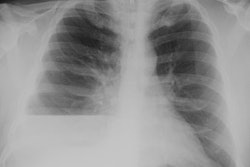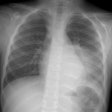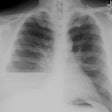Primitive Neuroectodermal Tumor (Askin's tumor):
View cases of Askin's tumor
Clinical:
PNET's are rare undifferentiated sarcomas that probably develop from cells of neural crest origin. Extraskeletal Ewing sarcoma or PNET located in the thoracopulmonary region is referred to as an Askin tumor [3]. The lesion primarily involves the chest wall, but rarely it may occur as a primary parenchymal neoplasm. The lesion is typically seen in young adults and children- most patients are usually between the ages of 3-38 years and females are affected more than males (3:1; 75% of cases) [3]. Patients most commonly complain of chest wall pain. Cough, dyspnea,weight loss, and fever are less frequent complaints. The lesion is associated with a chromosome 22 translocation [2]. The lesion has also been reported to occur after radiation therapy for Hodgkins lymphoma [2]. Metastatic disease is found in 10% of cases at presentation. Treatment consists of resection, augmented by chemotherapy and radiation therapy [2]. The overall survival is less than 40% at 2 years [2]. Factors associated with a poor prognosis include metastases at the time of diagnosis and an inability to completely resect the mass [2].
X-ray:
The lesion typically appears as a large, unilateral soft tissue
chest wall mass associated with local rib
destruction in 50-63% of cases (associated with increased tracer
activity on bone scan). An associated large pleural effusion is
common [3]. Calcificaiton is uncommon and seen in only 10% of cases [3].
The lesion is usually heterogeneous at CT due to internal hemorrhage and necrosis.
REFERENCES:
(1) AJR 1997; Primary primitive neuroectodermal tumor of the lung. 169: 1201-1202. (No abstract available)
(2) Radiographics 2002; Gladish GW, et al. Primary thoracic
sarcomas. 22:
621-637
(3) Radiographics 2013; Murphey MD, et al. From the radiologic pathology archives. Ewing sarcoma family of tumors: radiologic-pathologic correlation. 33: 803-831




